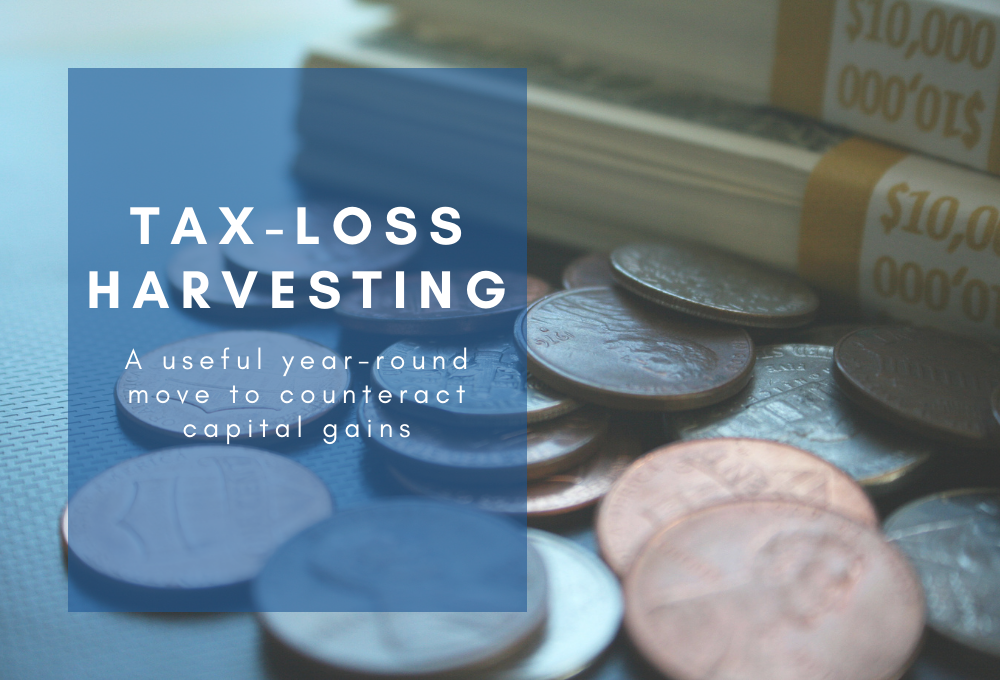The jury is still out and there are 2 full quarters left to know how the year will end up in regard to stocks, you could realize capital gains, which of course, is a taxable event. What can you do about them? You can do what some investors do – you could recognize investments with a loss and practice “tax-loss harvesting.”
Before we take a deep dive into tax-loss harvesting keep in mind this article is for informational purposes only. It’s not a replacement for real-life advice, so make sure to consult your tax-smart financial advisor and accounting professional before modifying your investment strategy.
Selling losers to offset winners. Tax-loss harvesting means taking capital losses (you sell securities worth less than what you first paid for them) to help offset the capital gains you may have recognized. Keep in mind that the return and principal value of securities will fluctuate as market conditions change and past performance is no guarantee of future returns.1
While this doesn’t get rid of your losses, it can be an approach to managing your tax liability.
The tax-saving potential.
Sure, you can use this technique to put your net gains at $0, but that’s just a start. Up to $3,000 of capital losses in excess of capital gains can be deducted annually, and any remaining capital losses above that can be carried forward to, potentially, offset capital gains next year. But remember, tax rules are constantly changing, and there is no guarantee that the treatment of capital gains and losses will remain the same.1
So, by taking losses this year and carrying over the excess losses into the next, you can potentially offset some (or maybe all) of your capital gains next year.
The strategy in action.
It is really quite simple. Step A is to pick out the losers in your portfolio. Step B is deciding which losers to sell. Step C is giving the green light to those transactions. Your portfolio may reflect your time horizon, risk tolerance, and investing goals. So, before moving ahead with a trade, it’s important to understand the role each investment plays in your portfolio.1
You must watch out for the I.R.S.’s “wash-sale rule,” however. You can’t claim a loss on a security if you buy the same or a “substantially identical” security within 30 days before or after the sale. In other words, you can’t just sell a security to rack up a capital loss and then quickly replace it. Your investment professional can illustrate how a “wash sale” works.1
Watch the fine print on wash sales.
The wash-sale rule applies to your entire taxable portfolio, not just one taxable account within it. So, as an example, if you sell individual holdings of stock in a company, you still must wait for the wash-sale window to close before you can purchase shares of that same firm. Also, the wash-sale rule applies to multiple taxable accounts – worth remembering if you and your spouse file your taxes jointly.1
The (minor) drawbacks.
It’s important to stress that you may not wish to alter a carefully chosen portfolio simply for tax-loss harvesting, especially if it has been built for the long term.
You can only practice tax-loss harvesting in taxable accounts; tax-advantaged accounts are ineligible for this strategy. Transaction costs can add up, so think about those potential costs versus the overall strategy before you decide to activate this strategy.1
Often thought of as a year-end tactic, tax-loss harvesting can be incorporated into a year-round strategy. We are happy to help answer any questions you have about how you can harvest losses.
1 – Investopedia.com, February 26, 2019
 – Same Experienced Team!
– Same Experienced Team! 
